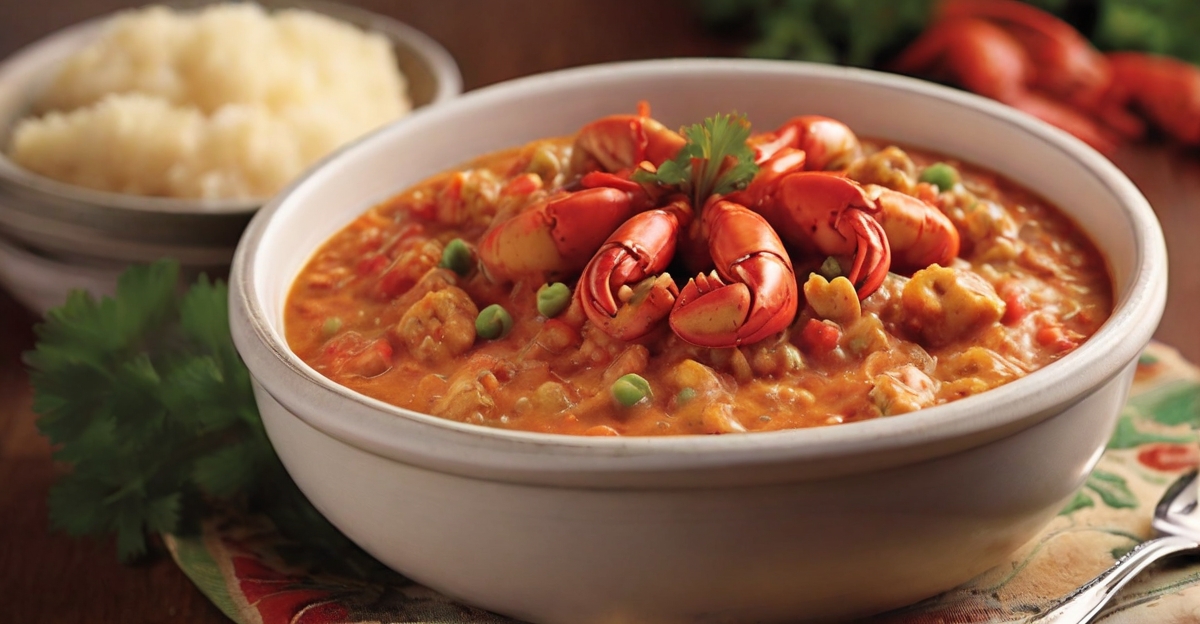Diving into the heart of Louisiana’s culinary treasures, Crawfish Etouffee emerges as a quintessential delight that marries the buttery, rich, and flavorful essence of local cuisine with the freshness of crawfish tails, herbs, and spices. This classic dish, known for its roux-based sauce and the holy trinity of vegetables with a hint of garlic, promises an out-of-this-world experience.
As someone who has spent countless weeknights crafting quick and easy meals, I’ve found that Crawfish Etouffee is worth the extra work. It’s a recipe that makes my family incredibly happy, filling our home with anticipation for seconds and even thirds.
Reflecting on the seasonal availability of seafood in LA, my access to fresh-caught ingredients has transformed my cooking adventures, especially with crawfish becoming a staple in my kitchen. Inspired by my popular Shrimp Etouffee, I decided to create a spin-off that captures the essence of this Louisiana classic during crawfish season.
Planning a trip to New Orleans to indulge in the local culture and seafood has always been on my bucket list, especially from late February until May, aligning perfectly with Lent and the peak of springtime and early summer. This period, stretching from November to July, offers the best crawfish, making every bite a celebration of tradition and taste.
What is Crawfish Etouffee?
Etouffee, pronounced AY-too-FAY, is a French term that vividly means smothered or suffocated. At its heart, this dish showcases crawfish tails luxuriously smothered in a rich and flavorful roux-based sauce. It’s a testament to the Southern culinary tradition, incorporating the holy trinity of onion, celery, and bell pepper with a dash of heat to create a symphony of flavors.
The process of making Crawfish Etouffee involves constant stirring to achieve a blond roux, which lends a deliciously nutty flavor to the dish. My journey into the world of etouffee introduced me to this culinary masterpiece, and I’ve since added my personal Imma touch with Creole Seasoning, elevating the dish’s complexity and depth.
A Personal Spin on a Classic
Crafting Crawfish Etouffee, for me, is more than following a recipe; it’s an expression of culture and heritage. The act of smothering crawfish tails in a sauce so rich and flavorful that it seems to suffocate the palate with taste, is something I’ve come to cherish. The roux-based foundation of the dish, heightened by the Southern holy trinity and that dash of heat, requires constant stirring but the result is a blond roux that’s nutty in flavor and unmatched in character.
This dish, with my addition of Creole Seasoning, becomes a bridge between traditional Southern cooking and my own culinary identity, making each bite a reflection of a journey both personal and steeped in tradition.
Recipe Ingredients
At the core of any memorable Crawfish Etouffee is the Roux, a blend of Butter and flour that introduces an intense flavor to the dish. This deliciously crafted base sets the stage for what’s to come. Integral to the recipe’s success is the Holy Trinity of Onion, green bell peppers, and celery, providing a perfect balance of flavors that are quintessential to etouffee. The process is simple, yet the outcome is anything but ordinary.
The Seasonings – Garlic, thyme, and bay leaves – add an incredible depth to the base of our etouffee. While fresh herbs elevate the dish, dried counterparts can be used without compromising too much on taste. The art of mincing garlic becomes second nature as you delve into more complex flavors, with homemade Creole seasoning acting as a significant flavor booster.
Tomatoes contribute a pleasant tanginess and a richer color, enhancing any dish they’re added to. However, they can be left out based on personal preference without detracting from the essence of the etouffee.
The undeniable star of the dish, Crawfish, is added last to prevent overcooking. For those without access to fresh crawfish, frozen varieties offer a practical alternative without needing to thaw, merely adjust the cooking time slightly. In a pinch, substitutes like Lobster or crab meat can be used, or one might opt for a Shrimp Etouffee variation.
How to Make Crawfish Etouffee
Crawfish Etouffee is a beloved dish from Louisiana, known for its rich, flavorful sauce and tender crawfish. This guide will take you through the steps to create this classic dish, complete with tips for ensuring your etouffee is as authentic and delicious as possible.
Preparing the Roux
- Start with the Basics: Begin by heating a mixture of butter and oil in a large Dutch oven or heavy-bottomed saucepan. This fat combination allows for a smooth roux without burning.
- Add Flour: Gradually whisk in flour until the mixture is smooth. This is the foundation of your roux, which thickens and flavors the etouffee.
- Cook to Perfection: Cook the mixture on medium heat, stirring continuously to avoid burning. Aim for a blond or peanut butter-colored roux, which should take about 10-12 minutes. The color of the roux will deeply influence the final taste and color of your etouffee.
Incorporating the Holy Trinity
- Vegetable Medley: Add chopped onion, green bell pepper, and celery to the roux. This combination, known as the “Holy Trinity” in Cajun and Creole cooking, is essential for the base flavor.
- Cook Until Softened: Saute the vegetables in the roux for 8-10 minutes, stirring frequently, until they are soft and fragrant.
Adding Seasonings and Seafood
- Boost the Flavor: Introduce garlic, thyme, and bay leaf to the mixture, continuing to stir for about 2 minutes. Then, add chopped tomatoes, Worcestershire sauce, paprika, and homemade Creole seasoning for an extra flavor punch.
- Simmer: Allow the sauce to simmer gently, adjusting the taste with stock, which adds depth and richness. This is also the time to adjust the seasoning with salt and hot sauce according to your preference.
- Crawfish: Add the crawfish tails last to prevent them from overcooking. Simmer the mixture for an additional five minutes to ensure the crawfish are heated through but still tender.
Final Touches
- Adjust Consistency: If necessary, adjust the thickness and flavor of the etouffee with more broth or water. This step is crucial for achieving the perfect etouffee consistency.
- Garnish and Serve: Finish the dish by stirring in green onions and chopped parsley for freshness. Serve your crawfish etouffee hot over cooked rice for a traditional presentation.
Making Crawfish Stock (Optional)
For an even more flavorful etouffee, consider making your own crawfish stock:
- Sauté Shells and Vegetables: In a separate saucepan, heat a bit of butter or oil and sauté crawfish shells, remaining scraps of onion, garlic, and celery along with aromatics like bay leaf and thyme.
- Add Water and Simmer: Cover the shells and vegetables with water, bring to a boil, then reduce the heat and let it simmer for about 20 minutes to extract all the flavors.
- Strain: Remove the pot from heat and strain the stock through a sieve to remove solids. Use this stock in place of water or commercial broth in your etouffee for a deeper flavor profile.
By following these detailed steps and incorporating the tips provided, you can create a delicious, authentic Crawfish Etouffee that captures the essence of Louisiana cooking. Enjoy the process and the delicious outcome!
How to Serve Crawfish Etouffee
Serving Crawfish Etouffee is an art that embraces both tradition and versatility. At its heart, this classic Louisiana dish is most traditionally served over rice, which perfectly pairs with the etouffee to soak up all the delicious flavor from the sauce. The rice acts as a canvas, allowing the rich, comforting essence of the etouffee to shine.
For those looking to step outside the box or for something less traditional, alternatives like cornbread, mashed potato, bread, or biscuits can offer a delightful twist, each bringing its unique texture and taste to complement the etouffee’s flavor.
Exploring further, grains such as quinoa or small pasta can serve as innovative bases, even if they diverge from the norm. Sides like a crisp salad or green beans can round out the meal, making it fuller and balancing the richness of the etouffee.
Whether celebrating Mardi Gras or simply enjoying a general day in, Crawfish Etouffee remains a comforting, easy to make, and easy to love dish. Its versatility in serving options ensures it can be tailored to any taste or occasion, making it a true testament to the joy of Louisiana cooking.
Tips and Tricks
- Avoid straight-tailed crawfish: Indicates they were dead before being cooked.
- Similar to lobster, crawfish go bad quickly when raw; thus, they must be cooked while still alive for optimal quality.
- When buying fresh crawfish, ensure they are alive; they can be kept alive for a day or two, but it is best to cook them immediately upon arriving home.
- Clean your crawfish thoroughly, as their nickname, mudbug, suggests their natural habitat and the necessity for cleanliness.
- Select crawfish of the same size for even cooking. Bigger crawfish are better, as they reduce the time spent peeling.
Conclusion
Making Crawfish Etouffee from scratch is an enriching culinary adventure that brings the heart and soul of Louisiana to your table. By carefully following the steps to prepare the roux, incorporating the Holy Trinity, seasoning generously, and treating the crawfish with care, you’re guaranteed a dish that’s rich in flavor, history, and tradition.
Whether it’s a special occasion or a desire to explore regional American cuisines, Crawfish Etouffee stands as a testament to the complexity and vibrancy of Creole and Cajun cooking, promising an unforgettable dining experience with every spoonful.
FAQs
Q1. What is crawfish etouffee made of?
Crawfish etouffee is a traditional Louisiana dish featuring crawfish tails smothered in a rich, flavorful sauce made from a roux (butter and flour), the Holy Trinity of onions, green bell peppers, and celery, along with garlic, spices, and often tomatoes. It’s commonly served over rice, highlighting its deep, comforting flavors.
Q2. What is etouffee vs gumbo?
Etouffee and gumbo are both staple dishes in Louisiana cuisine but differ in preparation and consistency. Etouffee is a thicker, stew-like dish focused on a single main ingredient (such as crawfish) smothered in a rich sauce. Gumbo, on the other hand, is a soupier dish that often combines a variety of meats or seafood and is thickened with okra, file powder, or a roux, served with rice.
Q3. Is crawfish etouffee healthy?
Crawfish etouffee can be part of a balanced diet when consumed in moderation. Crawfish are low in calories and fat while being a good source of protein and essential nutrients. However, etouffee’s traditional preparation includes a roux made with butter and flour, which can add to the dish’s calorie and fat content. Adjusting ingredients for a lighter version can make it healthier.
Q4. What does etouffee taste like?
Etouffee boasts a rich, complex flavor profile that is savory, slightly spicy, and deeply umami, thanks to the combination of crawfish, a buttery roux, and the Holy Trinity of vegetables. The addition of Creole or Cajun seasoning introduces layers of warmth and spice, making etouffee a hearty and comforting dish.
Q5. Is crawfish a fish or meat?
Crawfish, also known as crayfish or mudbugs, are not fish but freshwater crustaceans resembling small lobsters. They fall under the category of shellfish in the seafood family, making them a type of meat rather than fish.
Q6. Are crawfish fish or lobster?
Crawfish are crustaceans, similar to lobsters, but they are not fish. While they share some similarities with lobsters, such as their appearance and habitat (freshwater for crawfish, saltwater for most lobsters), crawfish are smaller and have a distinct flavor and texture that sets them apart from their larger marine cousins.

